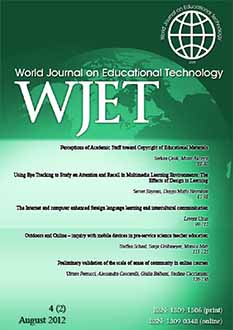Using Eye Tracking to Study on Attention and Recall in Multimedia Learning Environments: The Effects of Design in Learning
Using Eye Tracking to Study on Attention and Recall in Multimedia Learning Environments: The Effects of Design in Learning
Author(s): Servet Bayram, Duygu Mutlu BayraktarSubject(s): Education
Published by: Birlesik Dunya Yenilik Arastirma ve Yayincilik Merkezi
Keywords: Computer assisted simulation training; simulations; higher education; communication;
Summary/Abstract: In this study, the effect of multimedia learning environment prepared according to the attention types (focused -split) on recall performances of learners with attention level (high - low) was investigated by using eye movement measures. The participants were 37 undergraduate students who were presented with either focused attention or split attention multimedia learning environment. After attention levels of the learners were determined by d2 Test of Attention, they were separated to two groups as high and low. On the other hand, the instructional media were designed according to focused and split attention types. Multimedia in split attention type was applied to the half of the learners in groups determined with respect to attention level and multimedia in focused attention type was applied to the other half. Eye tracking (number of fixations, hetmap, dwell time)data were collected during the study. Their recall performances were measured with recall tasks. After that, the researchers evaluated recall performances of all learners and eye movement measures. According to Two Way ANOVA test results, it seems that application of different multimedia applications in terms of attention type on the learners having different attention capacities has no significant effect on number of fixations. The multimedia applications prepared in different attention types to the learners has significant effect on number of fixations.Attention capacities of learners have no significant effect on number of fixation. According to eye tracking measurements, in the focused attention multimedia application, it seems that the learners look at the parts where they are supposed to focus on and the most videos are shown. On the other hand, it seems that the learners look at the parts that video, text and picture are shown together in split attention multimedia application. According to Independent Samples t-test results, recall performances of the learners show a significant difference according to multimedia applications on behalf of focused attention multimedia application.
Journal: World Journal on Educational Technology: Current Issues
- Issue Year: 4/2012
- Issue No: 2
- Page Range: 81-98
- Page Count: 18
- Language: English

